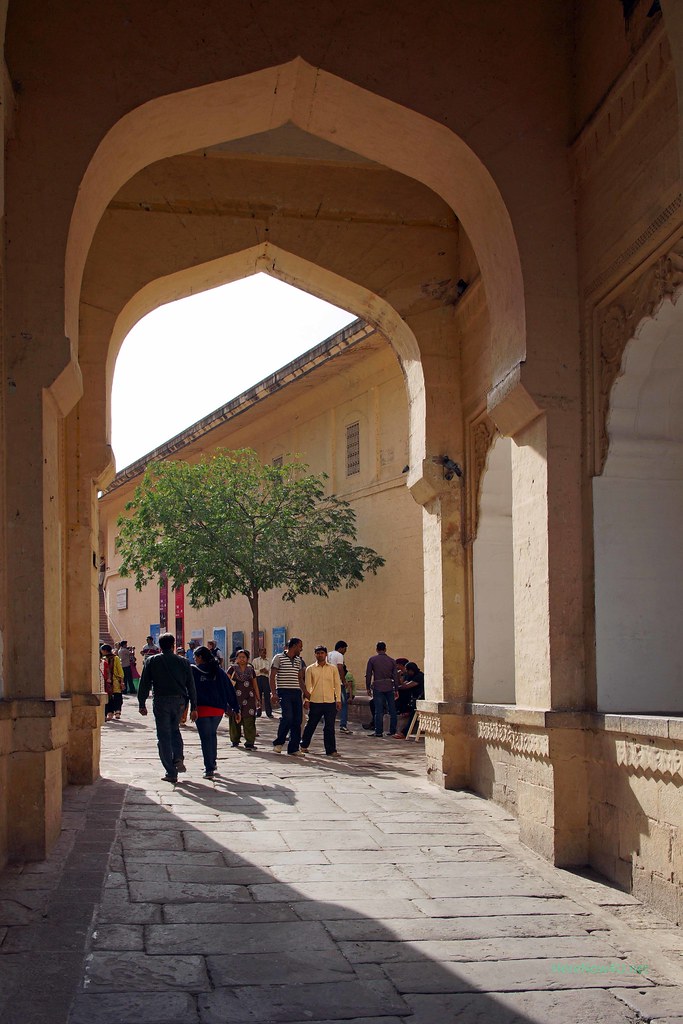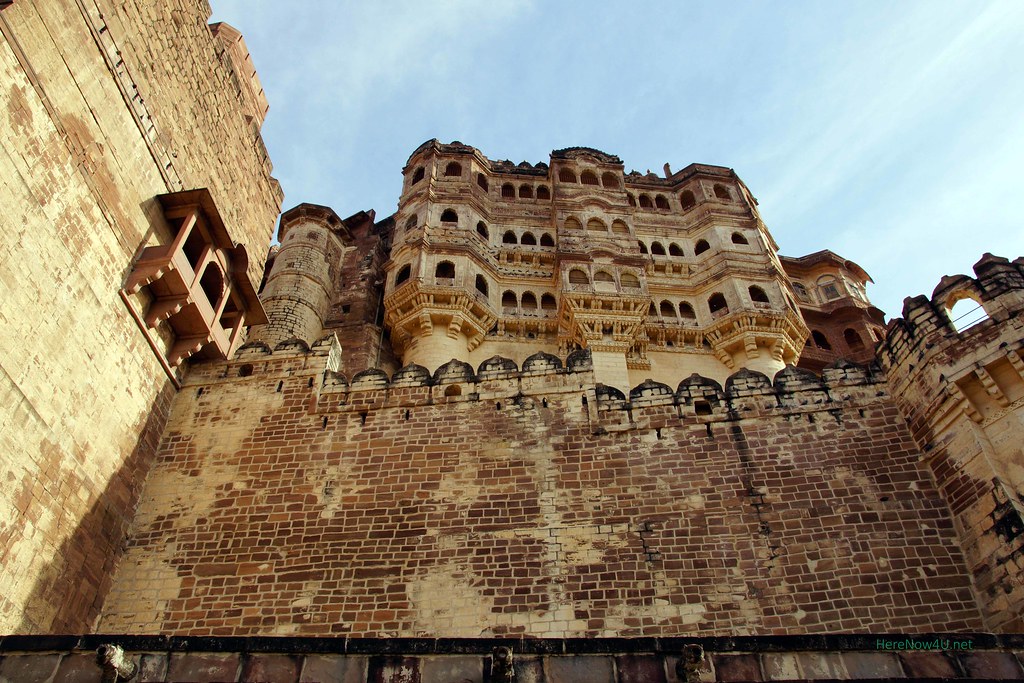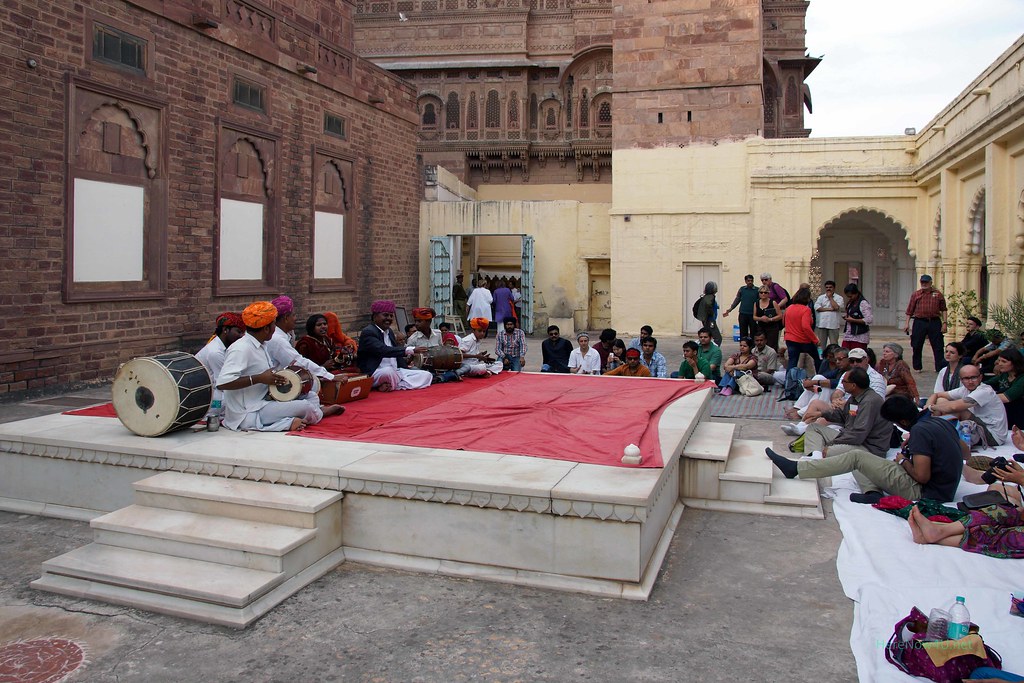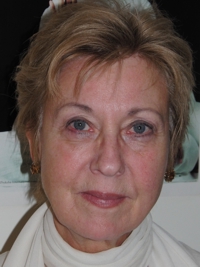In the afternoon we visited the other building, situated on a hill high above the town, Mehrangarh Fort. The 122m elevated solitary hill on which the fortress has been constructed immediately attracted the attention of King Roa Jodha 550 years ago when looking for an appropriate location for the head quarter of his clan. Mehrangarh Fort means “Fortress of the sun”. Since centuries this building surmounting the city also is a property of the Rathore clan until present. Its construction was started in 1459 as palace for King Rao Jodha, founder of Jodhagarh/Jodhpur. The king resided on the hill over his capital, which he had transferred from Mandore in 9km southern distance following a saint’s advice. The important Delhi-Gujarat trading route directly ran along here. In 1659 Maharaja Jaswant Singh completed the construction in fact, but his successors added yet new parts to it. Over the centuries an imposing complex was developed, surrounded by thick walls. Until 1943, the year of the completion of Umaid Bhawan it was still inhabited by the owners.
Parts of Mehrangarh Fort had been conserved and restored since 2006 in an interdisciplinary project supported by German Foreign Office and Mehrangarh Museum Trust founded in 1972 by Maharaja Gaj Singh, inspired by Berlin based art historian and restorer Christine Becker MA in cooperation between Indian and German restorers. Under the local climatic conditions certainly a challenge for all involved parties. The solid edifice hits a height of 120 feet at its highest point and has outer walls 70 feet thick. The complex has been formed by expansions and upgrades over centuries, which results in a very interesting mix of architectural styles. Until a spacious parking place it is possible to come by vehicles, but after it one has to walk or wait for the lift. The difference in levels corresponds to 4 floors.

To the right the extension of the parking place, to the left canteens. From here walking only.

First gate, entry to the castle of the sun

Typical wall decoration right from the entry

Gateway to first inner court, with cashier and entry to the lift, as well as coffee bars

Right from the cashier the UNESCO Award for Cultural Heritage Conservation
Who wants to walk to the highest point of the Fort and does not want to miss the view on town from above, has the passage of six gates ahead. In total there are seven gates, included the entry gate, which we had passed already. So we moved on unconcerned, as we thought a lift there. But having seen the queue to the lift and asked somebody how they yet had spent here, we decided to walk through the six gates ahead.

Only from the footpath this can be seen.

Behind the second gate…

…in a curve there is the first beautiful view to the valley.

Before passing the third gate (l) one should look up.

The fourth gate clearly shows that the ascent is not too abrupt.

Looking back gives an impression what has been achieved yet. Behind the wall the houses of Jodhpur are flashing in blue.

The fifth gate promises soon arrival on the top.

Done, gate no. 6.

Nowadays this building is - like many others on this hill - a huge museum, where interior, cloth, turbans, elephant howdahs and other royal palanquins as well as artfully done doors and windows can be admired.
The courtyard one enters after having passed the seventh gate, on the day of our visit has been decorated with colourful flags. The celebration of World Sufi Spirit Festival was announced in the newspaper, taking place the weekend from 22nd to 24th February in Mehrangarh Fort. Everywhere music could be heard, and the international audience was present in great number. First we wanted to look on the town from above, and then find out where the music originated.

One should be good on one’s feet for visiting the Fort. View on seventh gate, left the former Queen’s Palace with accommodation for the entourage.

Where once canons were talking, now families are sitting enjoying the view.

Jodhpur is also called „Blue City“, as members of Brahmin caste once had the privilege to paint their houses blue.

View from Mehrangarh Fort to Clocktower erected in 1912, one of Jodhpur’s famous sites, now surrounded by lively bazar.

Tree monument under which the children are playing.

One open door in the palace in front of the tree monument attracted our attention, and yet we were in a turban museum full of admirable presentations.

Fascinated by the music, we now followed our ears to find its source.

No wonder that music and location were in harmony:

One Rajasthani orchestra presented its music here.
The courtyard we entered was very convenient for the recital of music, good acoustic, not too big, open to the sky. There was a permanent coming and going. The international audience visibly enjoyed music and performance of a group originating from Thar Desert. The dances, the colourful clothes, and the sounds were composing an entity charming the audience by the authentic character of its presentation. The artists were highly motivated to give their best by the positive reaction of the audience. What an experience, free of charge and outdoors, as one says in Berlin. The saying of an Indian friend came to my mind, “Best things in life are free.” After leaving this court we entered the opposite court by an open gate, where a fairy-tale-like sight awaited us, and later on the guests.

In this ambiance the opening concert in the evening was announced for guests and visitors.

View on the famous exposition of elephant howdahs in Mehrangarh Fort

View from the window of one of the exhibition rooms

Made with love for detail: Door with typical local decoration

The city at feet: View from one wing of the palace

A jewel of the royal palanquin exposition

Wall decoration in one of the rooms in the palace

Royal hubble-bubble
Gradually dawn was approaching the city, and so did fatigue with us. What a memorable excursion into Jodhpur history!
Video: Some Desert Music

 Editor Carla Geerdes
Editor Carla Geerdes